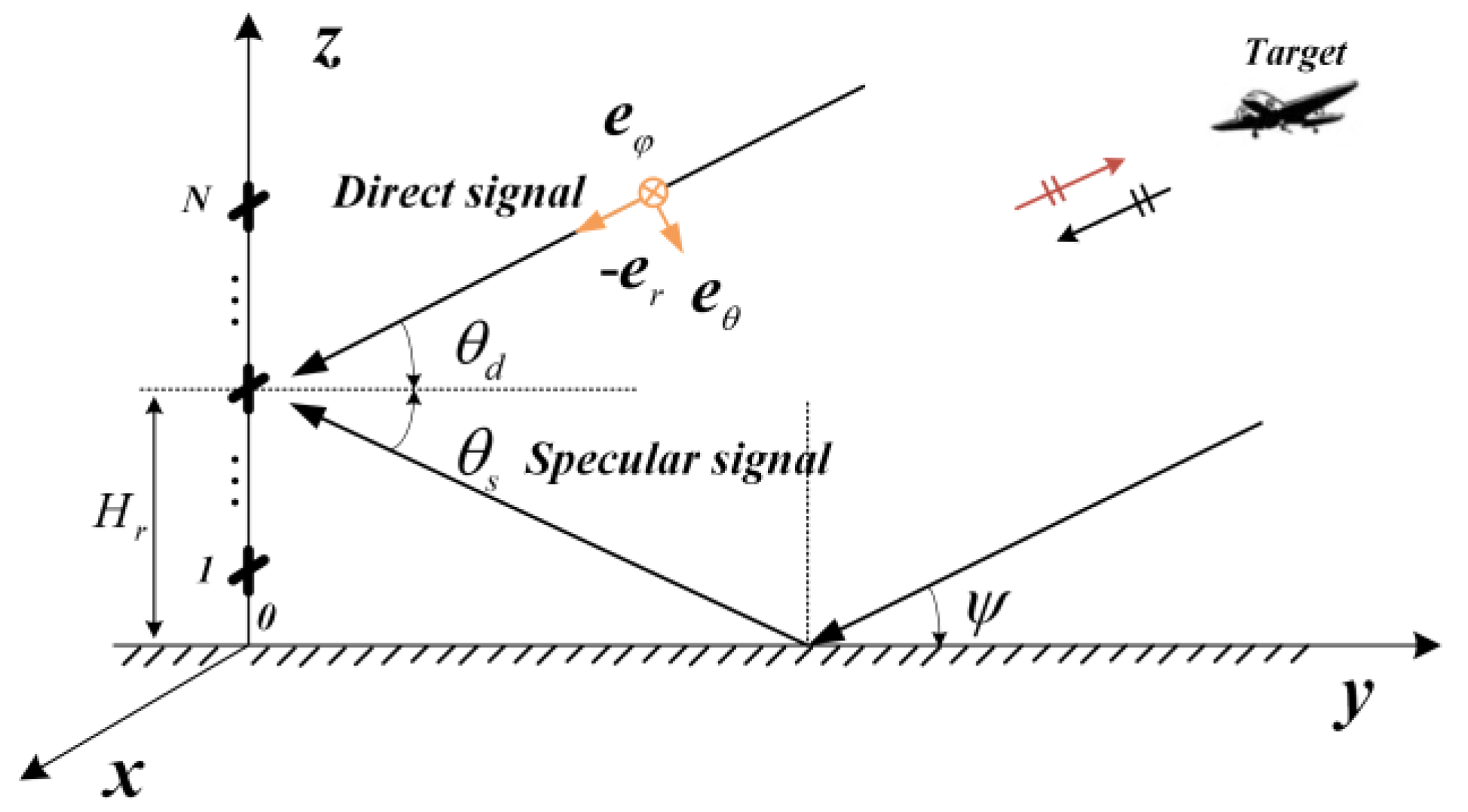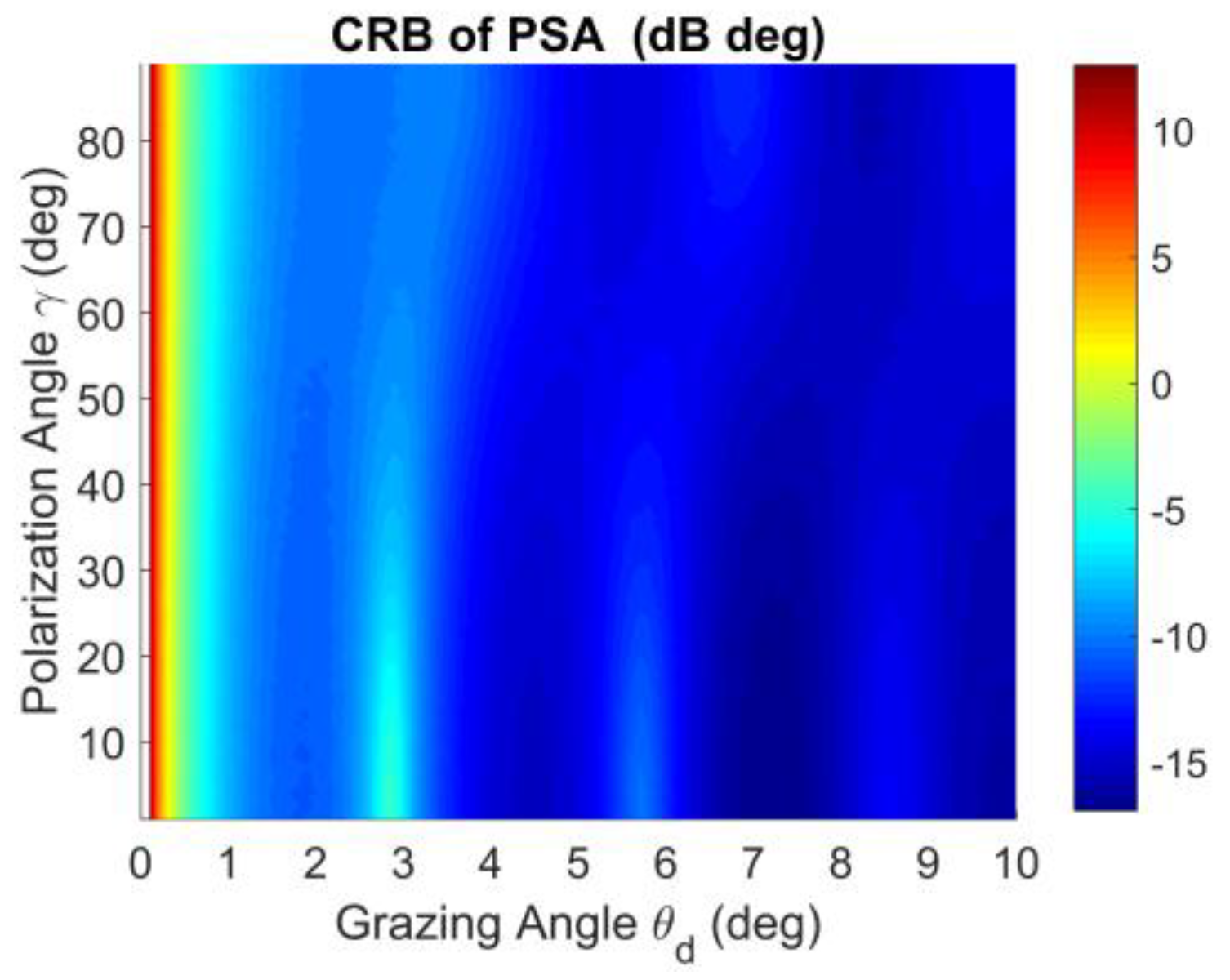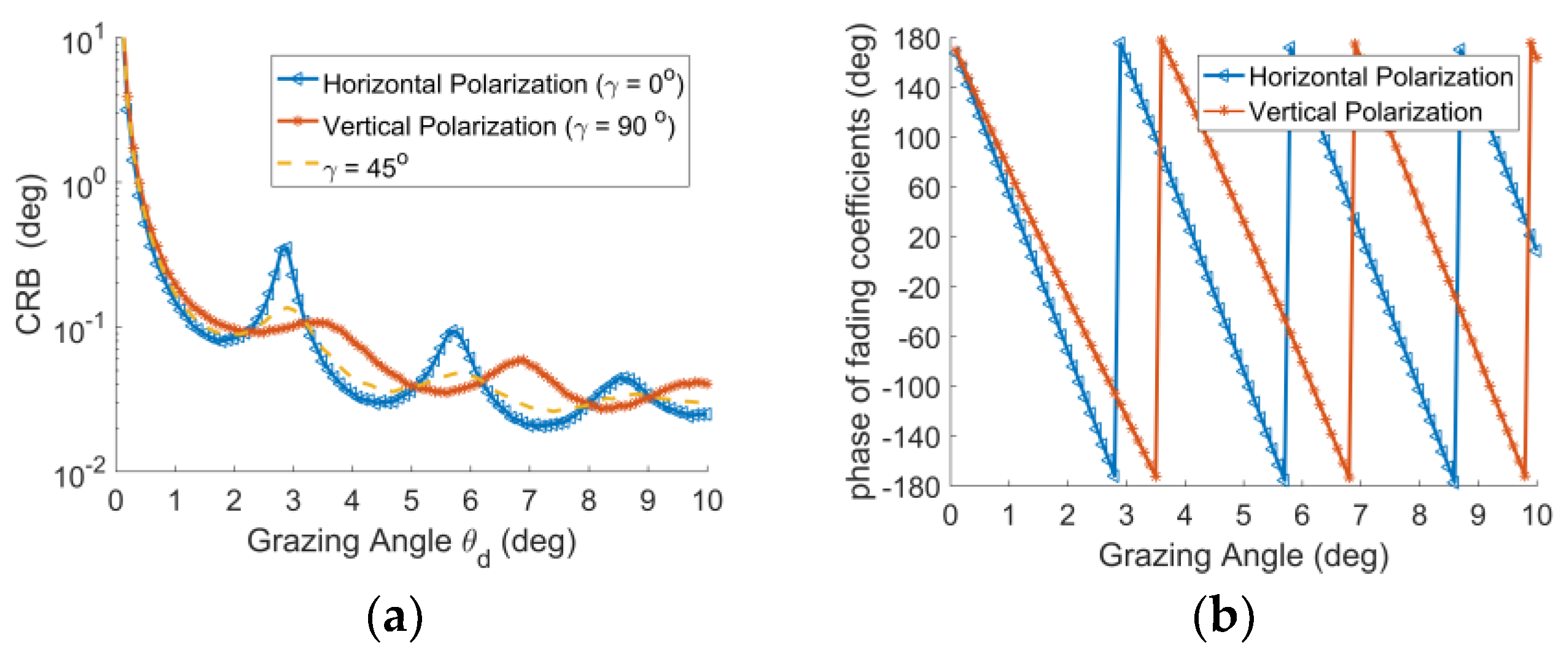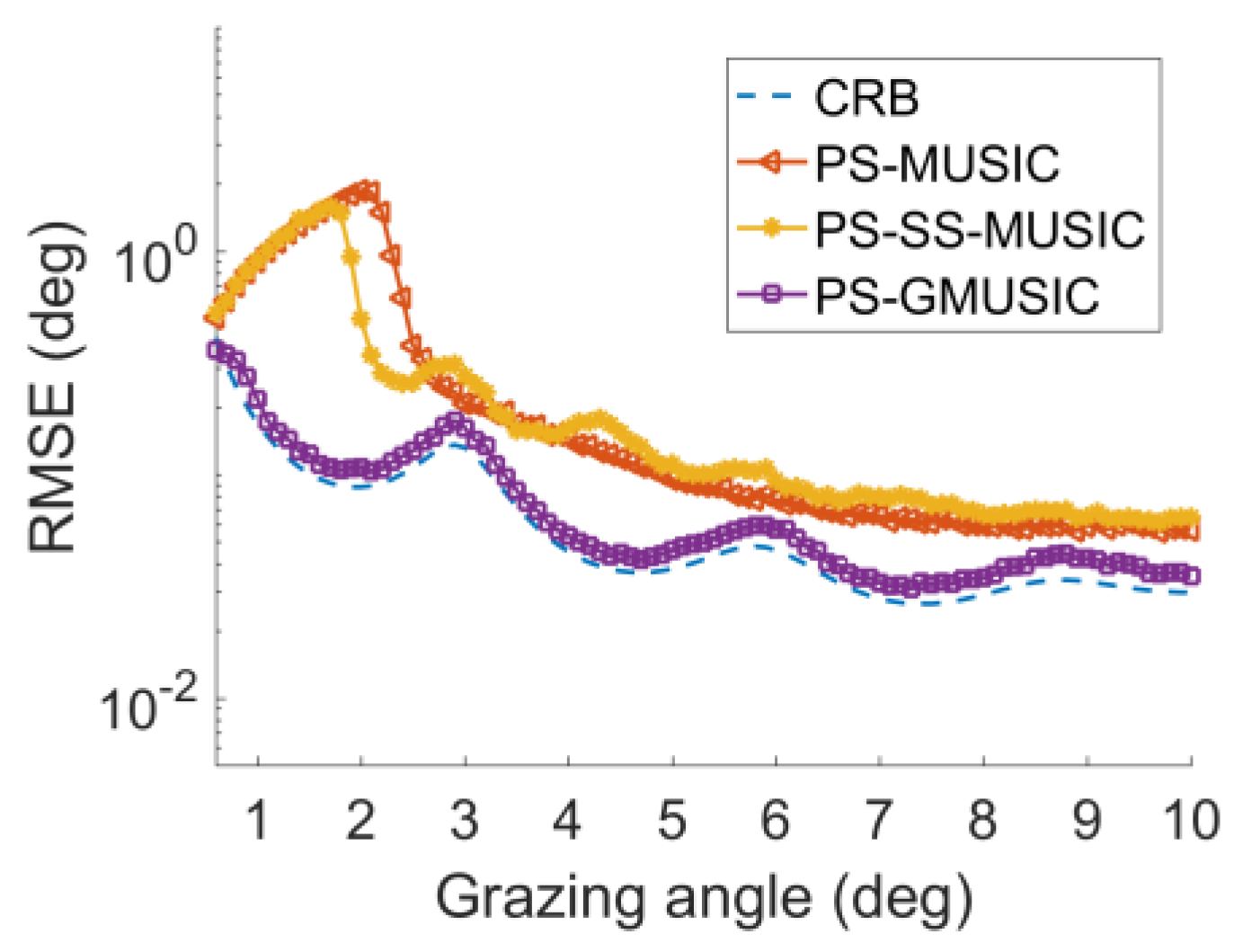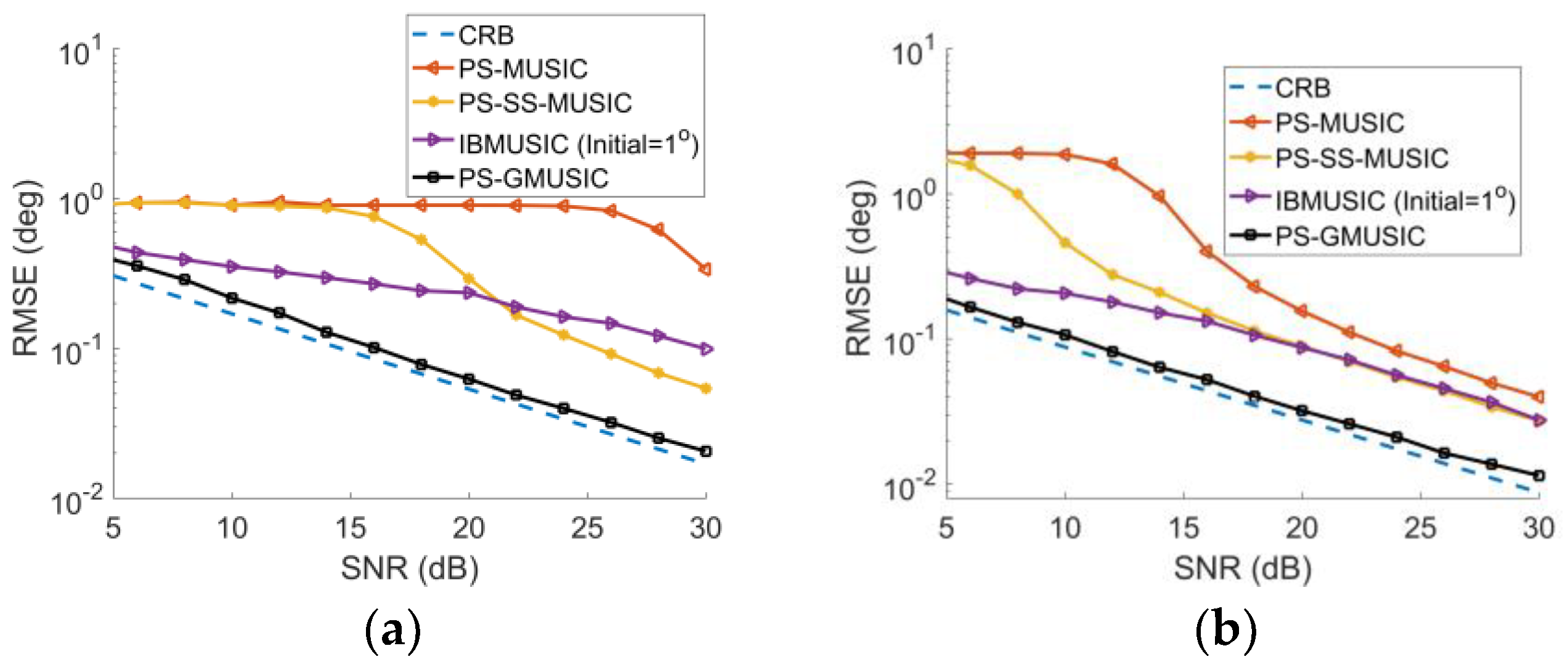1. Introduction
Meter wave radar is a direct and effective anti-stealth measure because the meter wavelength is located in the resonance band for most types of aircrafts, with the shape stealth technology being no longer valid in this band. Moreover, the wave absorbing efficiency of the dielectric coating is remarkably corrupted in this band [
1]. However, Direction of Arrival (DOA) estimation in low-angle areas is still one of the most challenging problems, especially for the Very High Frequency (VHF) radar system, which has antennae that are severely restricted in terms of aperture and height. The poor performance of the angle estimation and the height measuring, especially in the low-angle tracking area, limits the application of meter-wave radars. The cause of this problem is the existence of the multipath effect. In low-angle estimation for the VHF radar, the direct signal and multipath signal lying in the main lobe are coherent and therefore, it is difficult to distinguish them in the spatial, temporal and Doppler domains.
Many efforts have been exerted in the recent decades to overcome the multipath effect. These efforts can be mainly divided into two broad categories: the extended monopulse methods [
2,
3,
4,
5,
6,
7] and the array signal processing techniques [
8,
9,
10,
11,
12,
13,
14,
15,
16,
17,
18]. The former includes the complex indicated angle method, the double-null method and the fixed-beam method [
4,
5]. Although these methods have low computational complexity, the accuracy of the solution is reduced when the elevation angle of the incident wave is less than one-fourth of the beam [
3]. In [
6,
7], iterative processing was used to estimate the elevation angle based on monopulse techniques, calculating the reflection angle and updating the null position in beamforming to eliminate the multipath effect. However, these methods heavily depend on the electrical size of the antenna aperture, which is not suitable for meter-wave radar. The array signal processing methods are featured frequently in studies, such as Maximum Likehood (ML) approaches [
8,
12,
16,
18], multiple signal classification (MUSIC) algorithms [
10,
11,
16,
17] and so on. The ML method requires statistical information about the signals and its computational cost dramatically increases with an increase in the number of searching angles. The Refined Maximum Likehood [
8] (RML) method is based on a high determined multipath model, which is not always available in practices. The MUSIC algorithms use the subspace decomposition to differentiate between the direct and specular signals, which requires preprocessing to eliminate the coherence between the direct and specular signal for low-angle estimation problems. There are three main approaches to eliminate the coherence. First, there is the spatial smoothing method [
10,
11], which may reduce the effective array aperture length and result in lower resolution and accuracy. Second, there is the frequency diversity method [
19], which is based on the phase difference between the direct and the specular signals that varies with frequency. It is easily available with the X-band radar. Third, there is the polarization smoothing method [
16,
17]. This approach is based on the phase difference between the direct and the specular signals for different polarization. Unlike the spatial smoothing methods, the polarization smoothing method is not limited to a specific array geometry and it does not decrease the effective of array apertures [
16]. Furthermore, it does not require a wide bandwidth of frequency. In addition, a previous study [
20] indicated that the polarization diversity strategy has better performance than the frequency diversity method for low-angle estimation problem, even when using a smaller number of snapshots.
The polarization smoothing technique is based on the Polarization Sensitive Array (PSA). The PSA is exploited to resolve the low-angle estimation problem in this paper. The vector sensitive array was proposed for source localization by Nehorai [
21]. Rahamim proposed polarization-smoothing algorithm [
16] in the vector sensitive array under multipath conditions to decorrelate the coherent signals. Hurtado and Nehorai analyzed the Cramer-Rao Bound (CRB) of the vector sensitive array for low-angle tracking problems [
22], which indicated that the vector sensitive array has better performance than the traditional phase array. Xu developed the Polarization Smoothing MUSIC (PS-MUSIC) algorithm, which combines the Polarization Smoothing pre-processing and the MUSIC algorithm for low-angle tracking in VHF polarization sensitive radars [
17]. This approach is based on the phase difference of the reflected signals between the vertical and horizontal polarization. However, when the grazing angle is close to zero, there is very little difference in the reflection coefficient between the horizontal and vertical polarization, which leads to poor decorrelation performance for the polarization smoothing processing and poor low angle estimation performance. It can utilize spatial smoothing [
23] and polarization smoothing pre-processing simultaneously to improve the decorrelation performance, which could improve the low-angle estimation performance. The Polarization Smoothing and forward/backward Spatial Smoothing MUSIC (PS-SS-MUSIC) algorithm was discussed in a previous study [
16] for vector sensor arrays. However, the spatial smoothing procedure may cause the aperture loss as a trade-off, which could decrease the angle estimation accuracy. Although the polarization smoothing algorithm can be adapted to the multiple-input multiple-output (MIMO) radar system for coherent sources [
24,
25], the polarization smoothing algorithm cannot be directly utilized in the MIMO radar system for low-angle estimation due to the coupling term in the multipath signal [
26].
The Generalized MUSIC algorithm (GMUSIC) [
27] can be used to solve the low-angle estimation problem using the composite searching vector instead of ordinarily searching vector, which does not need to solve the coherent problem. However, the GMUSIC algorithm is unable to be applied when the phase of the fading coefficient is
for the traditional phase array. A PSA that contains the horizontal and vertical polarized components can fix that problem by using the different phases of the fading coefficient between the horizontal and vertical polarization. In order to improve the low-angle estimation performance, especially when the grazing angle is close to zero, the Polarization Smoothing Generalized MUSIC (PS-GMUSIC) algorithm is proposed in this paper. The proposed algorithm exploits the composite searching vector instead of ordinary searching vector, making it unnecessary to solve the coherent problem. Furthermore, the proposed method based on the PSA does not have limitations in terms of the phase differences between the direct and the reflected signals. In addition, the geometry information of the symmetry multipath model is exploited to transform the two-dimensional angle search into one-dimensional angle search in order to reduce the computational burden for the proposed algorithm. The simulation results indicated that the proposed method has better low-angle estimation performance than the PS-MUSIC and PS-SS-MUSIC algorithms.
The rest of the paper is organized as follows: the multipath signal model of the polarization sensitive array and the derivation of CRB are described in
Section 2. The polarization smoothing Generalized MUSIC algorithm (PS-GMUSIC) is proposed in
Section 3. The simulation results and discussions are presented in
Section 4. Finally,
Section 5 provides our conclusions.
2. Multipath Model for Polarization Sensitive Array
The multipath echoes are comprised of a single specular reflection and diffuse reflections. For a rough surface, the diffuse component dominates, while the reflected signals consist mainly of the specular component for a smooth surface. The ground can be considered as a smooth surface at the VHF band, because the Rayleigh roughness criterion can be easily satisfied due to the long wavelength based on the Rayleigh roughness criterion. Thus, the diffuse reflection components are ignored and the ‘double-ray’ symmetry multipath model is used, which is shown in
Figure 1.
As shown in
Figure 1, the N Polarization Sensitive Array (PSA) elements are uniformly distributed on the
Z-axis, while the orthogonal electric dipoles are arranged along the
X- and
Z-directions. The distance between elements is equal to a half-wavelength. In this figure,
is the height of the PSA;
is the elevation angle of the direct signal of the target;
is the depression angle of the specular signal; and
is the grazing angle of the target. According to the symmetry geometrical information of the symmetry multipath model (
Figure 1), we can obtain that:
Supposing the echo is a completely polarized wave as shown in the
Figure 1, the direct electric field vector can be expressed on the polarization basis
as:
where
is the polarization angle;
is the phase difference of the different polarized components;
are the unit vectors in the Spherical Coordinates with
and
; and
and
are the electric field amplitude of the unit vectors
and
respectively. Obviously, although there are three components of the completely polarized electric field, only two of them are independent. Hence, we assumed that
in this paper as shown in
Figure 1. The unit vectors of
and
can be simplified as
and
. The transformation between unit vectors in the spherical coordinates system and the Cartesian coordinate system is defined as:
The polarization vector
in Cartesian coordinate system of the PSA can be denoted as:
where
is the grazing angle of the direct signals and
(
Figure 1). The received signal for the PSA under multipath condition can be expressed as:
where
is the narrow band signal reflected from the target, with the assumption that
is a
Gaussian white noise vector with zero mean. Furthermore,
is the path difference between the direct and the specular signals; and
,
are the steering vector of the PSA for the direct and the specular signals, respectively. That can be denoted as:
where
denote the Kronecker product; and
and
are the steering vectors for the direct and the specular signals. These can be expressed as:
The
in Equation (5) is the Fresnel reflection coefficients vector that contains the horizontal and vertical polarization reflection coefficients, which can be denoted as:
For the horizontal polarization, the electric field is parallel to the interface. For the vertical polarization, the electric field is perpendicular to the interface as defined in a previous study [
28]. In this paper, the interface plane is XOY plane as shown in
Figure 1. Hence, the electric field in
direction is called the vertical polarization and the electric field in
direction is called horizontal polarization. The Fresnel reflection coefficients for horizontal and vertical polarization are defined respectively as follows [
28]:
The Fresnel reflection coefficients are determined by the grazing angle
and
. where
is the complex permittivity of the smooth ground;
represents the relative permittivity; and
is the conductivity of the reflective surface. When the grazing angle
is close to zero, we can obtain
. In other words, there is very little difference between
and
when the grazing angle is close to zero. In order to simplify the received signal in Equation (4), we used
to represent the composite vectors, with
denoted as:
where
is the fading coefficient vector of the PSA. It can be expressed as:
where
and
are the horizontal and vertical polarization fading coefficients, respectively. These are expressed as:
where
and
are the real parts of horizontal and vertical polarization fading coefficients, respectively; and
and
are the image parts of horizontal and vertical polarization fading coefficients, respectively. The fading coefficients are dependent on the grazing angle
, Fresnel reflection coefficient
and path difference
. By substituting Equation (10) into Equation (5), the received signals in Equation (5) can be simplified as:
In order to derive the CRB of the elevation angle
, we need to calculate the covariance of the received signal. The covariance of the received signal in Equation (13) is:
where
and
are the covariance of the signal and noise, respectively. We defined the signal-to-noise ratio of the completely polarized wave signal as:
. The CRB is a universal lower boundary for the variance of all unbiased estimators of a set of parameters. It is defined as the inverse of the Fisher information matrix (FIM), which describes the amount of information that the data provide about unknown parameters. According to the symmetry geometrical information of the symmetry multipath model as shown in
Figure 1, we can obtain
. Hence, there are nine unknown parameters
in the covariance matrix
. The Cramer-Rao Bound (CRB) of the elevation angle
for the PSA can be derived from FIM and the deduction process is included in the
Appendix A. The CRB for DOA of grazing angle
is:
3. Polarization Smoothing Generalized MUSIC Algorithm
As shown in
Figure 1, the received signals for the PSA under the multipath conditions for the coordinate’s axis can be expressed as follows [
17]:
where
is the composite steering vector that contains
and
. In addition, the
X-direction component corresponds to the horizontal polarization and the
Z-direction component corresponds to the vertical polarization. The covariance of each polarized components of the received signal in Equation (16) can be expressed as:
As we can see from Equation (17), there is only one larger eigenvalue in the covariance matrix
and
due to the coherence between the direct and the specular signals. The Polarization Smoothing algorithm was proposed by Rahamim [
16], which averages the data covariance matrix along the elements in the vector sensors of an array, with the averaging operation performed along the array aperture. The polarization smoothing pre-processing for VHF Polarization Sensitive Array under the multipath conditions can be summarized as:
where
is the averaged envelope covariance matrix of horizontal and vertical polarization subarrays. This can be derived as follows:
As we can see from Equation (19), we can obtain that
when
. This indicates that the polarization smoothing pre-processing could eliminate the coherence between the direct and the specular signals. Hence, there are two larger eigenvalues in the polarization smoothing average covariance
. The decorrelation performance of the polarization smoothing pre-processing is based on the differences of the
and
. The PS-MUSIC [
17] algorithm is established based on the polarization smoothing technique and MUSIC algorithm for low-angle estimation problem. However, when the grazing angle is close to zero, there is very little difference between
and
. Therefore, the decorrelation performance of the polarization smoothing method is reduced when the grazing angle is close to zero. In order to improve the decorrelation performance, the spatial smoothing processing can be exploited after the polarization smoothing pre-processing, which can be used to achieve the PS-SS-MUSIC algorithm. The PS-SS-MUSIC algorithm suffers aperture loss when the number of overlapping subarrays for the spatial smoothing is more than one. In contrast, GMUSIC [
27] can be used to solve the low-angle estimation problem, which does not need to solve the coherent problem. Hence, we developed a GMUSIC algorithm for the PSA.
As we can see from the multipath signal model in Equation (16), the covariance matrices
and
can be estimated with
snapshots by
and
. Furthermore, the sample polarization smoothing average covariance
can be estimated from Equation (18). The steering vectors
and
that correspond to the direct and the specular incoming signals in the signal subspace are therefore orthogonal to the noise subspace
. According to the orthogonality of the signal subspace to the noise subspace, we can derive:
where
is the projection matrix that is constructed from the eigenvectors
of the sample covariance matrix
corresponding to the
N-2 minimum eigenvalue. By constructing the projection matrix
, we obtain:
where
and
are the searching angles; and
is the composite steering vector. Obviously, the
is singular if and only if
or
. According to the geometry information of the symmetry multipath model, we assumed that
and
for the range of interest. Therefore,
is singular only if
,
, which can obtain that:
where
denotes the determinant of the matrix. Moreover, when
is equal to
,
also is singular, with the proof included in the
Appendix B. After this, the spatial spectrum of PS-GMUSIC is formed by projecting a continuum of composite DOA vector
over the given range of interest onto
, with the following form:
The proposed method exploits the composite steering vector
, making it unnecessary to solve the coherent problem. However, it requires a multidimensional search, which leads to a significant increase in computational burden. Additionally, based on the geometry of symmetry multipath model (
Figure 1), it can obtain the following expression for the searching angles:
Substituting Equation (24) into Equation (23), the two-dimensional angle searching in Equation (23) can be transformed into one-dimensional angle searching, which is:
Up to now, we have achieved the PS-GMUSIC algorithm. The procedure of the proposed method can be summarized as follows:
Construct sample covariance matrices and ;
Use the polarization smoothing pre-processing to get ;
Compute the noise subspace and Projection matrix by means of EVD (Eigenvalue Decomposition) using ; and
Establish the PS-GMUSIC spatial spectrum based on Equation (25).
The geometry information of the multipath model can be exploited to reduce the computational cost for the PS-GMUSIC algorithm. After the transformation from the two-dimensional searching into the one-dimensional searching, the computation burden of the PS-GMUSIC is , where is the number of the snapshots and is the number of the searching angles.
